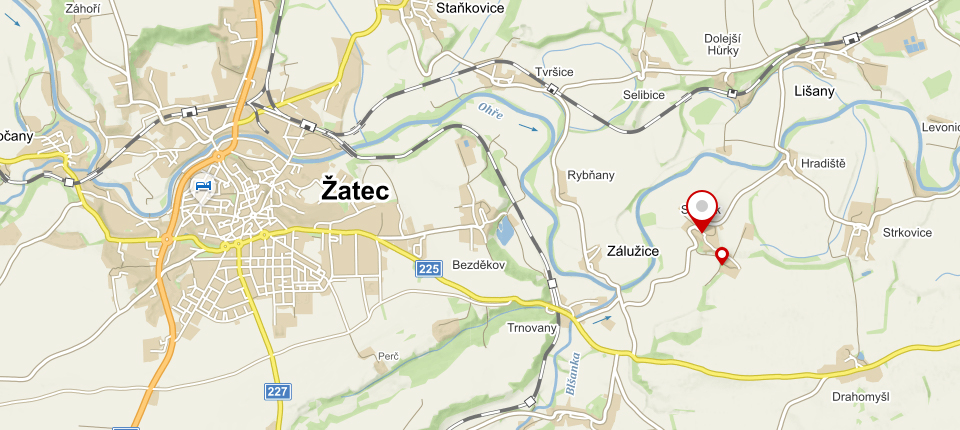HISTORICAL TRAIL POINTS
3. Castle history
The mansion on the site of today’s castle was probably builtaround 1600 during the reign of theKaplířdynasty of Sulevice. With the support of the Estates Rebellion, the fortress was confiscated to the Kaplíř dynasty. Subsequently, Aldringens, Jan Oldřich of Bissingeni and Lochner of Palič took turns in possession. In 1681 Jan Jiří Kulhánek bought the burned-out fortress,building a one-storey Baroque castle in its place. His grandson, Jan František Kulhánek of Klaudenstein, rebuilt the complexinto a Rococo style with Italian terraced gardens. From 1796 to 1892 the castle was owned by theKorbs of Weidenheim. After them the castle is inherited by theHannets, the veteran of Solferino battle Lothar Wenzl von Hennet and his son JUDr. Leopold von Hennet,who contributed significantly to the international renown of Stekník’s hops. Hans Gimbell,adirector of Hielle& Dittrich company, bought the castle from them. After his death, the castle was owned by his son-in-lawGeroldDéteindre, who was the Swiss consul. The Gimbell family owned the castle until 1949. The Czechoslovak State Farm’s, the Hop Research Institute and the National Gallery Depository in Praguesubsequently relieved them. Since 1997, the building has been administratedby the National Heritage Institute.
3 The history of the castle
The mansion on the site of today’s castle probably dates back to 1600 during the reign of Kaplíř of Sulevice. Stekník was confiscated for the support of the Czech Estates by Alexander Kaplíř of Sulevice. It was subsequently acquired in 1623 by Jan of Aldringen, an imperial general who participated in the murder of Albrecht of Valdštejn in Cheb. The Aldringen family held the estate until 1636, when it was bought by the colonel of the imperial army, Jan Oldřich of Bissingen.
In 1658-1681, the fortress was owned by Lochner of Palič, from whom the devastated fortress with the village bought a burgher Jan Jiří Kulhánek from Žatec, who built a one-storey Baroque castle on the site of the fortress. Jan Jiří Kulhánek was later promoted to a noble status and gained the nickname of Klaudenstein. Already his grandson, Jan František, rebuilt the castle in the years 1760-1783 to Rococo style. At that time, the southern wing of the castle, the salla terrena with the main hall, and the castle´s chapel of the Visitation of the Virgin Mary, the gardens and the Italian terraced gardens on the western and southern slopes of the castle were built. In 1796 the castle was bought by Josef Antonín Korb of Weidenheim. Together with his brother he got rich supplying the Austrian army in the Napoleonic wars and was promoted to a noble state. Both lines of the Korb family were connected through the marriage of Emilie and František Korb Jr. In 1892 the castle was inherited by Františka Korb, married to Baron Lothar Wenzl von Hannet, a veteran of the Battle of Solferino. Their son JUDr. Leopold von Hennet, former Austrian minister, in 1907 sold the castle to Hans Friedrich Gimbell, director of Hielle & Dittrich. He is passing that part of the caste to his son-in-low Gerold Detéindre.
Gerold Detéindre was the Swiss consul in Prague in 1912-1927. He also served as a president of the Swiss Association in Czechoslovakia for many years. After his death in 1940 the estate was inherited by his wife Hana and his sons Egon and René. The family owned the castle until 1949, when the castle was bought by the Czechoslovakian state under a so-called replacement contract. The castle was assigned to the administration of Czechoslovak State Farms and, since 1952, to the Hop Research Institute. In 1967 the castle was transferred to the National Gallery in Prague, which placed a depository of paintings in the castle. In 1997, the castle was transferred to the National Heritage Institute, which still manages it.
Remarks
During the World War II, a German forced administration was placed on the castle and the estate, which used Russian prisoners to work. They lived in poor conditions and were often abused.
Have you not visited the hop path yet?
So you can take a stroll and read interesting facts about hops and the place.
You are entering the grounds of the Hop Institute, where agricultural machinery moves all year around. Take extra care! Enter at your own risk.


OPERATOR OF HOP TRAIL
 | Hop Research Institute Co., LTD Kadanska 2525 438 01 Zatec |
 | www.chizatec.cz |
 | +420 415 732 111 |
 | info@chizatec.cz |
HOP TRAIL | |
 | Stekník, 438 01 Žatec |
DOČESNÁ - DEGUSTACE PIV
Beer tasting during the beer festival at the Hop Research Institute in Žatec.
-traditional event for invited experts and laics at the Hop Research Institute
-accompanying program at the beer festival













